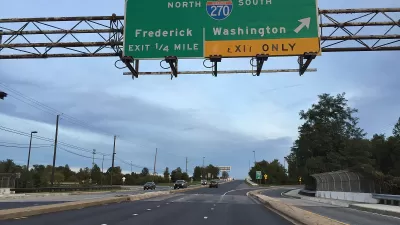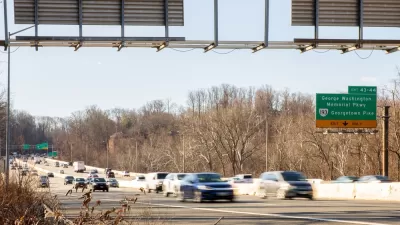A plan to widen Interstate 270 in Maryland was approved earlier this year under the condition that the state also study a plan to build a monorail along the route.

Dan Malouf writes: "Maryland will officially study a proposal to build a monorail along I-270, from Shady Grove to Frederick. Let’s examine whether that’s a crazy idea, or if monorail is a legitimate and practical possibility."
As noted by Malouf, the monorail feasibility plan is a component of a larger plan to widen I-270, approved by the Maryland Public Works Board in June 2019.
"If built, the foundation’s plan would see a 27-mile monorail, mostly along I-270, with six stops: Frederick, Urbana, Comsat (Clarksburg), Germantown, Metropolitan Grove, and Shady Grove. They say the elevated monorail would take 31 minutes to get from Frederick to Shady Grove, carry between 39,000 and 55,000 riders per day, and cost around $3.4 billion to build," explains Malouf.
Malouf digs into the strengths (e.g., lighter, cheaper, and aesthetic above ground) and weaknesses (e.g., must be elevated, can't switch tracks, potentially more expensive).
The High Road Foundation, the advocates behind the proposal, "seem most keen to provide a direct transit connection between Frederick and Montgomery County, according to Malouf, so the article also considers the potential of other modes (e.g., bus rapid transit, Metro rail, light rail, Diesel Multiple Units) to meet the need.
FULL STORY: Is a monorail on I-270 in Maryland a crazy idea? Here are its legit pros & cons

Trump Administration Could Effectively End Housing Voucher Program
Federal officials are eyeing major cuts to the Section 8 program that helps millions of low-income households pay rent.

Planetizen Federal Action Tracker
A weekly monitor of how Trump’s orders and actions are impacting planners and planning in America.

Ken Jennings Launches Transit Web Series
The Jeopardy champ wants you to ride public transit.

Crime Continues to Drop on Philly, San Francisco Transit Systems
SEPTA and BART both saw significant declines in violent crime in the first quarter of 2025.

How South LA Green Spaces Power Community Health and Hope
Green spaces like South L.A. Wetlands Park are helping South Los Angeles residents promote healthy lifestyles, build community, and advocate for improvements that reflect local needs in historically underserved neighborhoods.

Sacramento Plans ‘Quick-Build’ Road Safety Projects
The city wants to accelerate small-scale safety improvements that use low-cost equipment to make an impact at dangerous intersections.
Urban Design for Planners 1: Software Tools
This six-course series explores essential urban design concepts using open source software and equips planners with the tools they need to participate fully in the urban design process.
Planning for Universal Design
Learn the tools for implementing Universal Design in planning regulations.
Heyer Gruel & Associates PA
Ada County Highway District
Institute for Housing and Urban Development Studies (IHS)
City of Grandview
Harvard GSD Executive Education
Toledo-Lucas County Plan Commissions
Salt Lake City
NYU Wagner Graduate School of Public Service





























